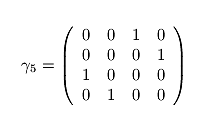

| Set QCD | |
|---|---|
| Source: | Bjoern Medeke, Department of Mathematics, Institute of Applied Computer Science, University of Wuppertal, 42097 Wuppertal, Germany. Phone: +49 202 439-3776. Email: [email protected] |
| Discipline: | Physics |
| Accession: | December 2000 |
Background. Lattice gauge theory is a discretization of quantum chromodynamics which is generally accepted to be the fundamental physical theory of strong interactions among the quarks as constituents of matter. The most time-consuming part of a numerical simulation in lattice gauge theory with Wilson fermions on the lattice is the computation of quark propagators within a chromodynamic background gauge field. These computations use up a major part of the world's high performance computing power.
Quark propagators are obtained by solving the inhomogeneous lattice Dirac equation Ax = b, where A = I - kD with 0 <= k < kc is a large but sparse complex non-Hermitian matrix representing a periodic nearest-neighbour coupling on a four-dimensional Euclidean space-time lattice.
From the physical theory it is clear that the matrix A should be positive real (all eigenvalues lie in the right half plane) for 0 <= k < kc. Here, kc represents a critical parameter which depends on the given matrix D. Denoting


Due to the nearest neighbour coupling, the matrix A has 'property A'. This means that with a red-black (or odd-even) ordering of the grid points the matrix becomes

Set of QCD Matrices. The QCD matrices provided in the set QCD consist of realistic matrices D generated at different physical temperatures b.
| matrix D | b | order | nonzeros | kc |
| conf5.0-00l4x4-1000.mtx | 5.0 | 3072 | 119808 | 0.20611 |
| conf5.0-00l4x4-1400.mtx | 5.0 | 3072 | 119808 | 0.20328 |
| conf5.0-00l4x4-1800.mtx | 5.0 | 3072 | 119808 | 0.20265 |
| conf5.0-00l4x4-2200.mtx | 5.0 | 3072 | 119808 | 0.20235 |
| conf5.0-00l4x4-2600.mtx | 5.0 | 3072 | 119808 | 0.21070 |
| conf6.0-00l4x4-2000.mtx | 6.0 | 3072 | 119808 | 0.15968 |
| conf6.0-00l4x4-3000.mtx | 6.0 | 3072 | 119808 | 0.16453 |
| conf5.4-00l8x8-0500.mtx | 5.4 | 49152 | 1916928 | 0.17865 |
| conf5.4-00l8x8-1000.mtx | 5.4 | 49152 | 1916928 | 0.17843 |
| conf5.4-00l8x8-1500.mtx | 5.4 | 49152 | 1916928 | 0.17689 |
| conf5.4-00l8x8-2000.mtx | 5.4 | 49152 | 1916928 | 0.17835 |
| conf6.0-00l8x8-2000.mtx | 6.0 | 49152 | 1916928 | 0.15717 |
| conf6.0-00l8x8-3000.mtx | 6.0 | 49152 | 1916928 | 0.15649 |
| conf6.0-00l8x8-8000.mtx | 6.0 | 49152 | 1916928 | 0.15623 |
References. A survey of lattice gauge theory is given in
A PostScript version of this information is also available.
![[conf5.0-00l4x4-1000 Icon]](conf5.0-00l4x4-1000_tiny.gif) conf5.0-00l4x4-1000 (complex unsymmetric, 3072 by 3072, 119808 entries), Quantum chromodynamics, b=5.0, kc=0.20611
conf5.0-00l4x4-1000 (complex unsymmetric, 3072 by 3072, 119808 entries), Quantum chromodynamics, b=5.0, kc=0.20611
![[conf5.0-00l4x4-1400 Icon]](conf5.0-00l4x4-1400_tiny.gif) conf5.0-00l4x4-1400 (complex unsymmetric, 3072 by 3072, 119808 entries), Quantum chromodynamics, b=5.0, kc=0.20328
conf5.0-00l4x4-1400 (complex unsymmetric, 3072 by 3072, 119808 entries), Quantum chromodynamics, b=5.0, kc=0.20328
![[conf5.0-00l4x4-1800 Icon]](conf5.0-00l4x4-1800_tiny.gif) conf5.0-00l4x4-1800 (complex unsymmetric, 3072 by 3072, 119808 entries), Quantum chromodynamics, b=5.0, kc=0.20265
conf5.0-00l4x4-1800 (complex unsymmetric, 3072 by 3072, 119808 entries), Quantum chromodynamics, b=5.0, kc=0.20265
![[conf5.0-00l4x4-2200 Icon]](conf5.0-00l4x4-2200_tiny.gif) conf5.0-00l4x4-2200 (complex unsymmetric, 3072 by 3072, 119808 entries), Quantum chromodynamics, b=5.0, kc=0.20235
conf5.0-00l4x4-2200 (complex unsymmetric, 3072 by 3072, 119808 entries), Quantum chromodynamics, b=5.0, kc=0.20235
![[conf5.0-00l4x4-2600 Icon]](conf5.0-00l4x4-2600_tiny.gif) conf5.0-00l4x4-2600 (complex unsymmetric, 3072 by 3072, 119808 entries), Quantum chromodynamics, b=5.0, kc=0.21070
conf5.0-00l4x4-2600 (complex unsymmetric, 3072 by 3072, 119808 entries), Quantum chromodynamics, b=5.0, kc=0.21070
![[conf6.0-00l4x4-2000 Icon]](conf6.0-00l4x4-2000_tiny.gif) conf6.0-00l4x4-2000 (complex unsymmetric, 3072 by 3072, 119808 entries), Quantum chromodynamics, b=6.0, kc=0.15968
conf6.0-00l4x4-2000 (complex unsymmetric, 3072 by 3072, 119808 entries), Quantum chromodynamics, b=6.0, kc=0.15968
![[conf6.0-00l4x4-3000 Icon]](conf6.0-00l4x4-3000_tiny.gif) conf6.0-00l4x4-3000 (complex unsymmetric, 3072 by 3072, 119808 entries), Quantum chromodynamics, b=6.0, kc=0.16453
conf6.0-00l4x4-3000 (complex unsymmetric, 3072 by 3072, 119808 entries), Quantum chromodynamics, b=6.0, kc=0.16453
![[conf5.4-00l8x8-0500 Icon]](conf5.4-00l8x8-0500_tiny.gif) conf5.4-00l8x8-0500 (complex unsymmetric, 49152 by 49152, 1916928 entries), Quantum chromodynamics, b=5.4, kc=0.17865
conf5.4-00l8x8-0500 (complex unsymmetric, 49152 by 49152, 1916928 entries), Quantum chromodynamics, b=5.4, kc=0.17865
![[conf5.4-00l8x8-1000 Icon]](conf5.4-00l8x8-1000_tiny.gif) conf5.4-00l8x8-1000 (complex unsymmetric, 49152 by 49152, 1916928 entries), Quantum chromodynamics, b=5.4, kc=0.17843
conf5.4-00l8x8-1000 (complex unsymmetric, 49152 by 49152, 1916928 entries), Quantum chromodynamics, b=5.4, kc=0.17843
![[conf5.4-00l8x8-1500 Icon]](conf5.4-00l8x8-1500_tiny.gif) conf5.4-00l8x8-1500 (complex unsymmetric, 49152 by 49152, 1916928 entries), Quantum chromodynamics, b=5.4, kc=0.17689
conf5.4-00l8x8-1500 (complex unsymmetric, 49152 by 49152, 1916928 entries), Quantum chromodynamics, b=5.4, kc=0.17689
![[conf5.4-00l8x8-2000 Icon]](conf5.4-00l8x8-2000_tiny.gif) conf5.4-00l8x8-2000 (complex unsymmetric, 49152 by 49152, 1916928 entries), Quantum chromodynamics, b=5.4, kc=0.17835
conf5.4-00l8x8-2000 (complex unsymmetric, 49152 by 49152, 1916928 entries), Quantum chromodynamics, b=5.4, kc=0.17835
![[conf6.0-00l8x8-2000 Icon]](conf6.0-00l8x8-2000_tiny.gif) conf6.0-00l8x8-2000 (complex unsymmetric, 49152 by 49152, 1916928 entries), Quantum chromodynamics, b=6.0, kc=0.15717
conf6.0-00l8x8-2000 (complex unsymmetric, 49152 by 49152, 1916928 entries), Quantum chromodynamics, b=6.0, kc=0.15717
![[conf6.0-00l8x8-3000 Icon]](conf6.0-00l8x8-3000_tiny.gif) conf6.0-00l8x8-3000 (complex unsymmetric, 49152 by 49152, 1916928 entries), Quantum chromodynamics, b=6.0, kc=0.15649
conf6.0-00l8x8-3000 (complex unsymmetric, 49152 by 49152, 1916928 entries), Quantum chromodynamics, b=6.0, kc=0.15649
![[conf6.0-00l8x8-8000 Icon]](conf6.0-00l8x8-8000_tiny.gif) conf6.0-00l8x8-8000 (complex unsymmetric, 49152 by 49152, 1916928 entries), Quantum chromodynamics, b=6.0, kc=0.15623
conf6.0-00l8x8-8000 (complex unsymmetric, 49152 by 49152, 1916928 entries), Quantum chromodynamics, b=6.0, kc=0.15623
[ Home ] [ Search ] [ Browse ] [ Resources ]
Last change in this page: Wed Sep 22 13:34:27 US/Eastern 2004 [Comments: ]